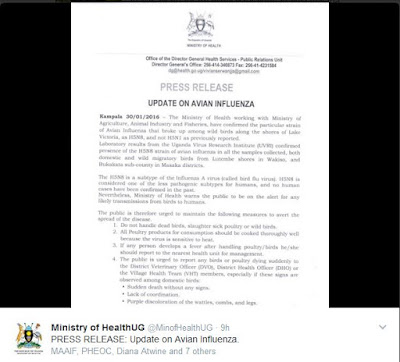#12,178
The reported mass die off of wild birds along the shores of Lake Victoria in Uganda 2 weeks ago was initially reported as HPAI H5 - with no subtype given (see Uganda: MOA Statement On HPAI H5 At Lake Victoria). Several days later local media began reporting this as H5N1, but until today, we've not seen anything official.
Earlier today, the Ugandan Ministry of Health tweeted a press release, stating the virus had been identified as H5N8 (see below).
While a reliable source, I've waited for the OIE Notification, which has just recently been posted on their website, in hopes it might provide us with additional detail.
 |
Epidemiological comments
Avian influenza (H5N8 strain) was detected and reported for the first time on 15 January 2017 in migratory birds, white-winged terns (Chlidonias leucopterus) at Lutembe beach, Kajjansi town council (Wakiso district) and in Kachanga village, Bukakata sub-county (Masaka district). An unconfirmed number of migratory birds have since then been reported to have died in Lutembe and Ddewe landing sites around Lake Victoria shores. In addition, white-winged terns, domestic ducks and chickens have been reported dead in different places in Bukakata (Masaka district) and Kalangala district. The Ministry of Agriculture, Animal Industry and Fisheries has informed the public that the risk to public health from the event is very low. All poultry farmers have been advised to take biosecurity and biosafety measures to control the outbreaks. In addition, the Ministry of Agriculture, Animal Industry and Fisheries has embarked on sensitizing, educating and training the high risk communities on the safety measures for limiting and controlling the outbreaks and a 3km (1.8 mile) quarantine/protection zone and 10 km (6.2 miles) surveillance zones have been put in place to prevent the spread of disease. A multi-spectral one health/eco health approach has been put in place to undertake investigations.
As the map below shows, the migratory flyway that funnels birds from Central Russia and parts of Asia to overwinter in warmer climes extends well into central, and even southern, Africa.
The detection of HPAI H5N8 in southern Uganda is by far the deepest incursion of Eurasian HPAI H5 that we've seen into Africa. Beyond the threat to local birds populations and poultry, these territorial gains could also provide the virus with fresh opportunities to reassort with other avian subtypes.
Of course, what flies south in the fall must return north in the spring.
Nearly six months ago, in Sci Repts.: Southward Autumn Migration Of Waterfowl Facilitates Transmission Of HPAI H5N1, we looked at a study that found southbound migratory birds in the autumn - coming from their northern breeding sites - are more likely to spread HPAI than the northbound flocks in the spring.
Researchers suggested that immunologically naive hatchlings - born over the summer - were more likely to spread HPAI viruses, which are believed to burn out fairly quickly in aquatic waterfowl populations (presumably due to their immunity to LPAI viruses).At least, that's the theory.
But this year we are seeing unusual persistence of both H5N8 (in Europe) and H5N6 (in Asia) in migratory birds, including waterfowl. Whether, how, or even if that will impact this year's return migration is a big unknown.
But given the unprecedented moves we've seen avian flu make over the past few months, we probably ought to expect the unexpected.


